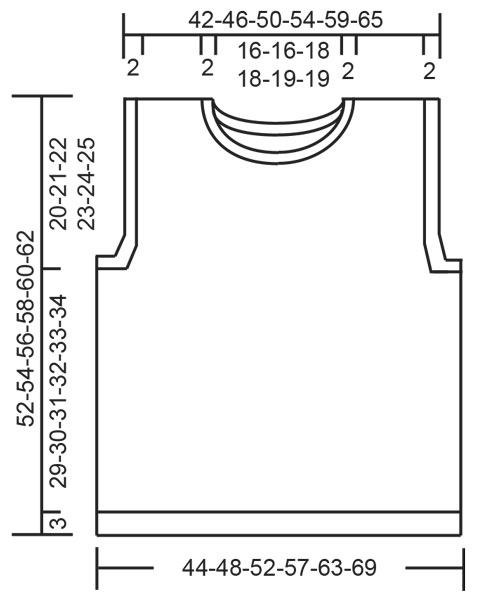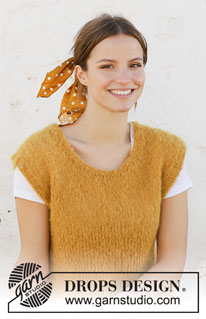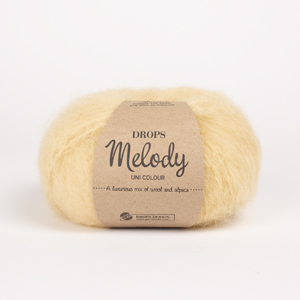Comments / Questions (28)
![]() Girardeau Danielle wrote:
Girardeau Danielle wrote:
Bonjour, j'ai diminué les mailles pour les emmanchures, ensuite il faut tricoter une maille lisière au point mousse et continuer le tricot séparément. Ma question doit-on mettre un dos ou un devant en attente sur une autre aiguille pour pouvoir continuer, je ne comprends pas tout a fait les explications. Merci pour la réponse
10.09.2024 - 16:41DROPS Design answered:
Bonjour Mme Girardeau, lorsque vous avez rabattu les mailles des emmanchures, vous allez mettre les mailles du devant en attente et tricoter celles du dos, en allers et retours (on ne tricote plus en rond maintenant). Quand le dos et le devant seront terminés séparément; vous ferez la couture des épaules puis vous relèverez les mailles autour de l'encolure pour tricoter le col et autour des emmanchures pour la bordure des manches. Bon tricot!
11.09.2024 - 08:02
![]() Desmet wrote:
Desmet wrote:
Bonjour pourquoi faut il diminuer des points aprés les côtes et pas l’inverse? Car du coup le bas avec les côtes risque d’être plus large non? Merci d’avance
09.05.2024 - 17:29DROPS Design answered:
Bonjour Mme Desmet, dans ce modèle, les côtes du bas ne doivent pas resserrer l'ouvrage et, comme il faut plus de mailles pour la même largeur pour tricoter des côtes avec des aiguilles 5,5 que du jersey avec des aiguilles 7, on va augmenter après les côtes. Bon tricot!
10.05.2024 - 08:41
![]() Olga Lucia wrote:
Olga Lucia wrote:
Son espectaculares todos los patrones me han servido muchísimo. Muchas gracias
01.05.2024 - 16:18
![]() Anne wrote:
Anne wrote:
Bonjour, Auriez-vous une vidéo à m'indiquer pour rabattre souplement le col en côtes 2/2 Merci pour votre réponse.
15.02.2024 - 01:39DROPS Design answered:
Bonjour Anne, vous trouverez différentes façons de rabattre les mailles ici, dans notre vidéothèque, notamment la technique à l'italienne. Bonnes finitions!
15.02.2024 - 07:44
![]() Elli wrote:
Elli wrote:
Danke für die Antwort, aber ich soll ja laut Anleitung nur 72 Maschen für Größe L aufnehmen, keine 100. Wie mache ich das?
03.07.2023 - 15:55DROPS Design answered:
Liebe Elli, sorry, ich habe die falschen Maschenanzahl geschrieben, Sie haben dann 28 M hinten + 28 M vorne, es sind dann 16 Maschen beidseitig um 72 Maschen zu haben; an den Seiten nehmen Sie nicht 1 Masche in jeder Reihe auf, aber diese 16 M beidseitig von der Schulternaht regelmäßig verteilt. Sollten Sie immer zuviele Maschen auffassen, dann können Sie auch bei der 1. Runde regelmäßig verteilt abnehmen. Viel Spaß beim stricken!
03.07.2023 - 16:06
![]() Elli wrote:
Elli wrote:
Hallo, wie kann ich denn aus dem Halsausschnitt für Größe L nur 72 Maschen aufnehmen? Wenn ich aus jeder Masche eine aufnehme, komme ich auf weit über 100 Maschen.
01.07.2023 - 14:58DROPS Design answered:
Dear Elli, nehmen Sie 28 Maschen am Halsausschnitt beim Rückenteil (die 26 abgekettene Maschen + 1 M beidseitig) und 28 Maschen am Halsausschnitt beim Vorderteil (die 16 abgekettene Maschen + 6 Maschen beidseitig) + 22 Maschen beidseitig zwischen Hals vorne und hinten, so haben Sie 100 Maschen. Viel Spaß beim stricken!
03.07.2023 - 10:09
![]() Addi wrote:
Addi wrote:
Hallo, wie ist das genau gemeint, was muss ich tun, das „innerhalb“ verstehe ich hier nicht: „je 1 Masche innerhalb 1 kraus rechten Rand-Masche abnehmen,“. Danke!
28.06.2023 - 20:59DROPS Design answered:
Liebe Addi, nehmen Sie 1 Masche am Anfang der Hin-Reihe nach der Randmaschen (die krausrechts gestrickt wird) ab und nehmen Sie 1 Masche am Ende der Hin-Reihen vor der Randmasche (die krausrechts gestrickt wird) ab. Viel Spaß beim stricken!
29.06.2023 - 12:47
![]() Audrey wrote:
Audrey wrote:
Bonjour, quand j'arrive au col et que je relève les mailles j'ai 120 mailles en faisant tout le tour ... 😳 Et dans l'explication il est mentionné 68 mailles... Je ne vois pas comment un tel écart est possible. Auriez-vous une suggestion ? Merci bien
20.04.2023 - 13:32DROPS Design answered:
Bonjour Audrey, relevez peut-être moins de mailles sur les côtés le long des épaules - cf vidéo (entre les mailles rabattues pour l'encolure et celles rabattues pour l'épaule); vous pouvez ajuster le nombre de mailles au 1er tour à un nombre divisible par 4 - vous pouvez ensuite ajuster le nombre en fonction de comment vous souhaitez l'encolure (plus ou moins échancrée). Bon tricot!
20.04.2023 - 16:25
![]() Anne wrote:
Anne wrote:
After the piece is worked to 32cm, do I cast off 4 stitches on each side of marker that is on cast on, and then cast off two stitches on each side of the center marker that is after 58 stitches?
04.03.2023 - 02:20DROPS Design answered:
Dear Anne, you need to cast off 4 stitches in total on each side (under the arm), which means that you cast off 2 stitches on each side of the markers (which are marking the sides). So you cast off 4 stitches on each side, not 4 +2 stitches. Happy knitting!
05.03.2023 - 20:33
![]() Eva Sjoelund wrote:
Eva Sjoelund wrote:
Hej kan det verkligen bara vara 68 maskor man ska sticka upp på halskanten i storlek s. Till ärmkanten ska man sticka upp 64 vilket låter rimligare. Jag frågade detta även den 9:e juli. Hoppas på svar snart
20.07.2022 - 18:17DROPS Design answered:
Hej Eva, Der er mange som har strikket vesten og har ikke hørt noget om at det ikke passer.... Vil du have halsen større så er det naturligvis bare at strikke flere masker op :)
03.08.2022 - 15:28
Golden Treasure#goldentreasurevest |
|
 |
 |
Knitted vest / slipover with round neck in DROPS Melody. Size: S - XXXL
DROPS 212-17 |
|
|
---------------------------------------------------------- EXPLANATION FOR THE PATTERN: ---------------------------------------------------------- DECREASE TIP (evenly): To calculate how to decrease evenly, use the total number of stitches on row (e.g. 132 stitches) and divide stitches by number of decreases to be done (e.g. 16) = 8.25. In this example knit approx. every 7th and 8th stitch together. GARTER STITCH (back and forth): Knit all rows. ---------------------------------------------------------- START THE PIECE HERE: ---------------------------------------------------------- VEST - SHORT OVERVIEW OF THE PIECE: Work piece in the round on circular needle up to armhole, then divide the piece, and work front and back piece back and forth separately. Work neck edge and sleeve edges in the round on a short circular needle. BODY: Cast on 132-140-156-172-188-208 stitches on circular needle size 5.5 mm with Melody. Knit 1 round. Then work rib knit 2 and purl 2 until piece measures 3 cm. Switch to circular needle size 7 mm, and work 1 round in stocking stitch while decreasing 16-16-20-24-24-28 stitches evenly– read DECREASE TIP in explanation above = 116-124-136-148-164-180 stitches. Insert one marker at beginning of round and one marker after 58-62-68-74-82-90 stitches, move the markers upwards when working. REMEMBER THE KNITTING TENSION! Then work in stocking stitch until piece measures 32-33-34-35-36-37 cm from cast-on edge. On next round cast off 4-4-4-6-6-6 stitches for armholes in each side, cast off 2-2-2-3-3-3 stitches on each side of each marker. Then work front and back piece separately with 1 edge stitch in garter stitch in each side. BACK PIECE: = 54-58-64-68-76-84 stitches. Work as before and decrease 1 stitch inside 1 edge stitch in garter stitch in each side 2 times = 50-54-60-64-72-80 stitches. Work until piece measures approx. 50-52-54-56-58-60 cm from cast-on edge. On next row from right side divide the piece and decrease for neck edge as follows: Work the first 13-15-17-19-22-26 stitches, cast off the next 24-24-26-26-28-28 stitches and work the rest of row. Now work shoulders separately but do not cut the yarn. Work left shoulder from here. LEFT SHOULDER (back piece): = 13-15-17-19-22-26 stitches. Begin from wrong side and work as before the rest of row. Cast off 1 stitch at the beginning of next row from right side and work the rest of row = 12-14-16-18-21-25 stitches. Work 1 row from wrong side and cast off by knitting from right side. Piece measures 52-54-56-58-60-62 cm in total from cast-on edge. RIGHT SHOULDER (back piece): = 13-15-17-19-22-26 stitches. Begin from right side and work as before the rest of row. Cast off 1 stitch at the beginning of next row from wrong side and work the rest of row = 12-14-16-18-21-25 stitches. Work 1 row from right side and cast off by purling from wrong side. Piece measures 52-54-56-58-60-62 cm in total from cast-on edge. FRONT PIECE: = 54-58-64-68-76-84 stitches. Work as before and decrease 1 stitch inside 1 edge stitch in garter stitch in each side 2 times = 50-54-60-64-72-80 stitches. Work until piece measures 40-42-44-46-48-50 cm from cast-on edge. On next row from right side divide the piece and decrease for neck edge as follows: Work as before over the first 18-20-22-24-27-31 stitches, cast off the next 14-14-16-16-18-18 stitches by knitting, work as before over the last 18-20-22-24-27-31 stitches. Now work shoulders separately but do not cut the yarn. Work right shoulder from here. RIGHT SHOULDER (front piece): = 18-20-22-24-27-31 stitches. Work as before, begin from wrong side, and cast off for neck at beginning of every row from right side 3 stitches 1 time, 2 stitches 1 time and 1 stitch 1 time = 12-14-16-18-21-25 stitches. Continue until piece measures 52-54-56-58-60-62 cm in total, and cast off by knitting from right side or purling from wrong side. LEFT SHOULDER (front piece): = 18-20-22-24-27-31 stitches. Work as before, begin from right side, and cast off for neck at beginning of every row from wrong side 3 stitches 1 time, 2 stitches 1 time and 1 stitch 1 time = 12-14-16-18-21-25 stitches. Continue until piece measures 52-54-56-58-60-62 cm in total, and cast off by knitting from right side or purling from wrong side. ASSEMBLY: Sew the shoulder seams together. NECK EDGE: Pick up stitches inside 1 stitch along neck edge with circular needle size 5.5 mm. Begin from right side at the shoulder seam. Pick up approx. 68-68-72-72-76-76 stitches (must be divisible by 4). Work rib with knit 2/ purl 2 for approx. 2½ cm. Loosely cast off stitches with knit over knit and purl over purl. SLEEVE EDGE: Pick up stitches inside 1 stitch along armholes with a short circular needle size 5.5 mm. Begin from right side at the armhole. Pick up approx. 64-80 stitches (must be divisible by 4). Work rib with knit 2/ purl 2 until rib measures approx. 2½ cm. Loosely cast off stitches with knit over knit and purl over purl. Work the other sleeve edge the same way. |
|

|
|
Have you finished this pattern?Tag your pictures with #dropspattern #goldentreasurevest or submit them to the #dropsfan gallery. Do you need help with this pattern?You'll find 23 tutorial videos, a Comments/Questions area and more by visiting the pattern on garnstudio.com. © 1982-2025 DROPS Design A/S. We reserve all rights. This document, including all its sub-sections, has copyrights. Read more about what you can do with our patterns at the bottom of each pattern on our site. |
|

























































Post a comment to pattern DROPS 212-17
We would love to hear what you have to say about this pattern!
If you want to leave a question, please make sure you select the correct category in the form below, to speed up the answering process. Required fields are marked *.